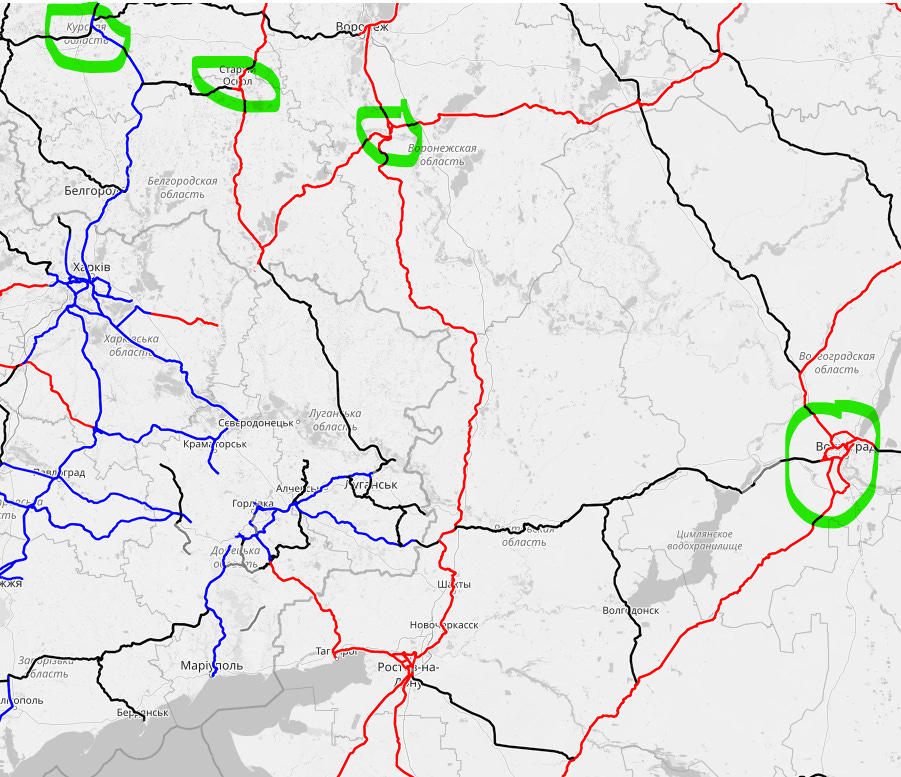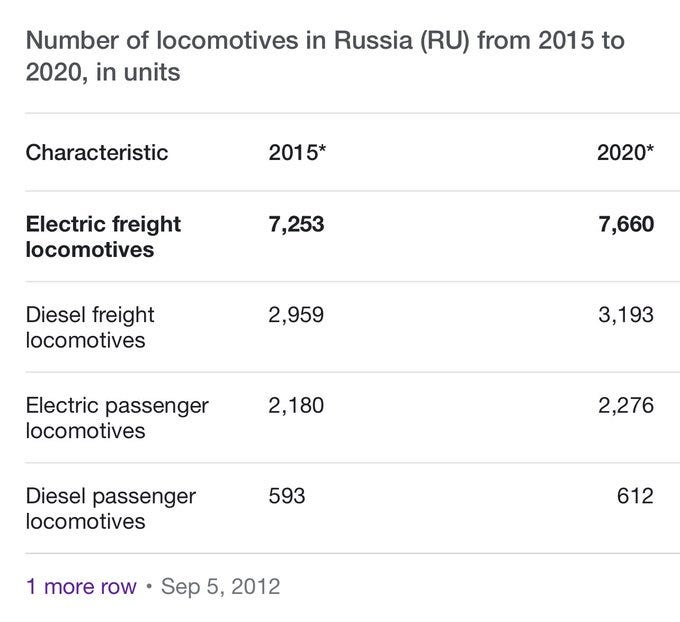Some Russian railways thoughts inspired by recent threads from TrentTelenko(https://threadreaderapp.com/user/trenttelenko) and Prune602 (https://threadreaderapp.com/user/Prune602) on the Xitters. There are four rail nodes in increasing distance from Ukraine that, if taken out, will completely screw Russian supply to the war zone. They are Kursk (or any where south of it), Stary Ospol, Liski and somewhere around Volgograd. See this openrailwaymap and the following screenshot of it.
These nodes are key because they are junctions on the electrified main lines to the border area and especially (in the case of the last two) to Rostov-on-Don which Russia uses for all it’s logistics into the southern section of the war. The first two take out logistics for Kursk/Karkiv area and one major access to Belgorod (for Northern Lukhansk) respectively. Russia relies on its electrified lines as it has far more electrical locomotives than diesel.
Ukraine has already done major damage to the first link and it is almost in artillery range (probably in HIMARS range already, if the US allows that). The second seems to be about 100 miles as the drone flies from Sudzhy so it is in easy drone range. The third is about 80 miles further and thus also not that hard to reach in theory. Volgograd OTOH is a lot further away and definitely a “stretch goal”, however taking out Liski would force all supplies to Rostov to go via Volgograd. Given recent reports of Russian Railways chaos and maintenance issues this could be enough because it is likely that the frequency of trains on that line would result in derailments or other accidents that would jam it up without Ukrainian assistance.
By attack what do I mean?
I don’t neccessarily mean destroy bridges or track - though those are fine targets - there’s also the electrical supply infrastructure. The overhead powerlines themselves can be cut by drones as can the posts they are supported by. But wait.. there’s more.
The transformers and substations that supply power to the lines are also vulnerable and probably not hard to identify on satellite maps and the helpful openinframap site. Taking out transformers puts load on other parts of the power grid for weeks or months until they can be replaced (and in Russia months could stretch to years or never for big transformers) and that will cause overloads and failures.
Signalling stations and links are also vulnerable. Consider the recent attacks on the French TGV network. Now it is true that France repaired that damage fairly quickly. But France is neither short of trained manpower nor is it in a war and subject to sanctions. Spare parts are easily obtained and transported in France, this is less likely to be the case in Russia.
Critically many spare parts in Russia are preferentially moved by rail so if you break the rail network there’s a chicken and egg issue to the repairs in that you need the railways to ship the equipment to repair the railways…
What about roads?
In other nations road transport has gradually taken the place of rail for many many things. There are times when you need to move megatons of stuff from point A to point B and trains are absolutely better and more efficient for doing that compared to road, however in other nations even these megatons of stuff are typically palletized and containerized and do the last few miles on trucks having been offloaded by cranes and forklifts from the rail cars.
Russia doesn’t do that. Some of this is sensible in that Russian roads are generally bad even at the best of times and frequently near impassable. Some of this is not, in that Russian military logistics is not palletized and containerized so any mode transfer means human stevedores humping the stuff. Trent Telenko has been scathing about this for the last two years
So taking out key nodes of the Russian rail network will force collapse because there aren’t the trucks or truck drivers to make the deliveries and the there isn’t the infrastructure to handle the transfers from truck to truck or truck to rail and vice versa.
Railways are vulnerable
A final point. Unlike, say, airfields or ammo dumps railways stretch a very very long way. That’s the whole point, especially in Russia which is a truly enormous country. But unlike roads there typically aren’t bypasses available for when the rail line is out in one spot. As you can see from the map at the top of this post if you take out a few nodes then there are no ways around. None. No bypasses or old roads on the other side of the valley. And this is particularly true of electrified ones. If the line is not electrified then your electric locomotives can’t go there. So if you take out the junctions between different electified lines and/or the junctions between electrified and non-electrified lines then you break the network.
Worse, it’s hard to overtake trains. On a single track line it is impossible. On a double track line there are only occasional places where someone built the points to allow a train to move from one track to another. If you take the power out an electric train will stop where it is. If it stops near to a train in the opposite direction there may be no way to change tracks between them.
Russia is aware of this and has railway repair workers ready to spring into action ASAP when there’s an issue. But even though these repair teams exist, if there are enough hits in enough places then they can’t fix them all. This is the sort of thing that drone warfare is excellent at. There’s no need to hit the (probably defended) marshalling yard or junction. Just take out a rail or an overhead wire 2 miles out one way and 5 miles out another. Keep doing this. Every day and twice on Sundays.








Let’s see how this plays out. Could be fun.
Historically, taking out rail logistics is very difficult. The Western Allies put a major effort into it in France before D-Day but the Germans were still able to move and re-supply. I think your points about the vulnerability of electric trains does make it easier but not sure Ukraine has the capacity to sustain an anti-rail effort.